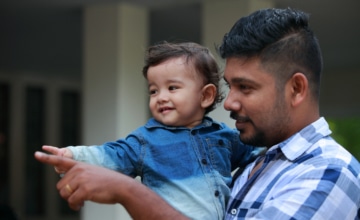Marisa Macy, University of Central Florida
Stephen J. Bagnato, University of Pittsburgh UCLID-LEND Disabilities Institute
Krisztina Weiszhaupt, University of Central Florida
Abstract
The Division for Early Childhood (DEC) lists 11 recommended practices for assessment, including “Practitioners report assessment results so they are understandable and useful to families” (DEC, 2014, p. 8). This article examines high-impact practices designed to make meaningful and understandable assessment reports to facilitate goal-planning and creating individualized interventions for children and their families. The authors share professional strategies for facilitating effective communication of the assessment process and of results with families of young children.
Professionals prefer to use “authentic assessments” to identify strengths and needs of infants, toddlers, and preschool children, especially, those with developmental delays and disabilities within early childhood intervention programs (Bagnato, Goins, Pretti-Frontczak, & Neisworth, 2014; Lee, Bagnato, & Pretti-Frontczak, 2015). Authentic assessments are mandated by standards and practices of major early childhood professional organizations (e.g., National Association for the Education of Young Children, Division for Early Childhood [DEC], Head Start). Authentic assessment is developmentally appropriate, observation-based, and collaborative; authentic assessment of a child’s typical competencies occurs during everyday routines and activities across multiple people (e.g., parents, family members, other familiar professionals) and across multiple settings (e.g., home, preschool, and community).
Parents’ Role in Authentic Assessment
Authentic assessment relies on the observations, reports, and judgments of familiar and knowledgeable caregivers in a child’s life with whom the child has an attachment relationship (Bagnato, 2007; Macy, Bagnato, & Gallen, 2016). Authentic assessment focuses on individual strengths, while also documenting the child’s less well-developed competencies; most important, the process relies on a parent’s pivotal role as a team member engaged in assessment. It is imperative that family members feel comfortable during the process so they can share crucial information about their children, and easily express concerns and needs. Parents must feel that they are valuable members of the team whose involvement in the assessment and planning process is essential and indispensable. Many families can experience anxiety and uncertainty if they do not understand their role in assessment and if they don’t know what to expect (Wolfe & Durán, 2013). Building a relationship with families is essential to maximize parents’ engagement in assessment and to foster communication with professionals. Positive and trusting relationships will enhance parental collaboration with the rest of the team and enrich the portrait of the child in everyday life.
High-impact practices for sharing assessment results with families are a priority. The Division for Early Childhood (DEC) outlined 11 recommended practices for assessment. The eleventh DEC practice recommendation states, “Practitioners report assessment results so that they are understandable and useful to families” (DEC, 2014, p. 8). Understanding family cultural beliefs, values, communication needs, and priorities for their child are vital, as demonstrated in the following vignette.
Daniel’s Individualized Family Service Plan (IFSP) Meeting
Daniel, a 13-month-old boy, was born prematurely and was diagnosed with cerebral palsy soon after birth. Due to his high muscle tone, Daniel demonstrates delay with his motor and self-help skills. He has not started to roll yet, he has poor head and trunk control, and his parents have some difficulties with his feedings. Daniel and his family have been receiving services from the local early intervention provider agency since he was 1 month old. Ava and Peter, Daniel’s parents, are attending his annual IFSP meeting with his team. The meeting was scheduled for early evening hours so both parents could attend and also because, as Ava indicated, these hours fit best in Daniel’s daily schedule, as he is most active in the afternoon. Ava and Peter feel relaxed and comfortable with the meeting, because they are aware of the structure and goal of the assessment process. By using authentic assessment protocol, the team has multiple opportunities to observe Daniel engaging in activities that naturally occur in his everyday life. They receive a complex picture of his developmental stage by observing his excitement when Peter arrives from work, and by watching Daniel’s behavior during game activities when he plays with his favorite toys. The evaluation process continues with parent interviews and review of results of previous observations. Ava and Peter have plenty of opportunities to ask questions related to their specific concerns regarding Daniel’s development and needs. Their specific questions, such as: “How can we help Daniel to play with his toys?”, or “What are best ways to support him during feeding?” can assist the team to address these specific concerns in their reports. The assessment concludes with the development of outcomes and strategies. The team carefully listens to parental comments, writes strategies that truly reflect family’s needs, and develops a curriculum to promote Daniel’s development. Active parental involvement in the process resulted in an atmosphere where the family’s needs were respected and outcomes support Daniel’s development.
High-impact practices designed to promote meaningful, understandable, and collaborative communications throughout the authentic assessment process will facilitate collaborative goal-planning and create individualized interventions for children and their families. Communicating with families about results of authentic assessment should directly link to goals and strategies. Families need “real-talk” and “real-interactions” during the assessment–intervention process so that outcomes and results answer their pressing questions and they will be empowered to engage professionals with trust, clarity, and collaboration and to advocate most effectively for their children.
Writing effective assessment reports requires both art and science. Effective communication is fundamental, and the writer must understand the varied communication needs of parents, family members, and other professionals. In reality, few individuals who are required to write assessment reports know how to do it well. Too often, report writers use a format that mirrors a medical model and includes confusing jargon. Parents need clear, concise, and practical assessments and interpretations of the meaning of results.
Relatively few studies have been conducted on identifying the most effective styles of writing reports and most of those studies were conducted nearly 50 years ago. Bagnato (1980, 1981) conducted comparative research on the use of develop-mentally based, and question-answer (Q&A) type of diagnostic reports versus traditional test-centered psychoeducational reports written by school psychologists working with preschool children. Results demonstrated that parents preferred developmental and Q&A reports which focused on developmental competencies (i.e., both strengths and needs) and functional goals embedded within the authentic assessment scale’s skill sequences. These reports allowed both parents and professionals to readily and effectively identify specific goals for individualized program planning in Individualized Education Plans (IEPs) and IFSPs. Developmentally appropriate assessment and Q&A reports discussed the child’s capabilities in colloquial terms, avoided jargon and labels, and identified next-step skills for individual instruction and intervention. Authentic assessments provide a link between curriculum-based assessment instruments, encourage teamwork and collaboration among parents and professionals, define the best medium to communicate those results for each parent/family, and result in the identification of individual developmental goals in assessment to child’s individual instructional plan (Bagnato, McLean, Macy, & Neisworth, 2011).
Guidelines for Family-Friendly Communication
Effective communication begins with nurturing a trusting relationship with parents and family members. When assessment is viewed as embedded within the program’s instructional and therapeutic goals and activities on a daily basis, both parents and professionals become used to assessment–curriculum linkages and the monitoring of child status and progress as familiar activities. Similarly, when familiar and knowledgeable teachers, paraprofessionals, and specialists are visible and available on a regular basis within the home or center, parents become comfortable with collaboration. We offer the following guidelines (see Table 1) for professionals to enhance communication with parents about their children’s capabilities, needs, and potential for developmental progress as they approach school-age.
Set the Stage and Support Family Choice

Taking time to build trusting relationships with families can build on family strengths. Avoiding reports focused on deficits and highlighting “assets” is a trend that is gaining momentum and a preferred practice by professionals and parents. Using the family’s preferred way of contact, determine the daily routine of the child and the best time to orchestrate assessment. Schedule assessment when it is convenient for the family and an optimal time for both parent and child. Provide families the opportunity and time to explain their concerns and needs. Asking open-ended questions will facilitate conversation and encourage parents’ participation. Ensure that family members understand the purpose of assessment and are familiar with the structure of the process. Offer opportunities for the family to ask questions about each professional’s role and experience. Practitioners should view these questions as a vital “stage-setting” for a positive and trusting partnership with parents. In general, use family-friendly words and avoid jargon; professional verbal and written communication should be accessible to all families. Jargon-free materials make it easier to communicate content, as well as to build positive relationships by facilitating clear communication. Convey respect by putting the person before the disability in using people-first language. Focus on the strength and what the child can do. Make sure family members are familiar with any important terms and that they understand questions or statements about their child’s abilities.
Choose Authentic Assessment Measures to Describe Child Capabilities and Needs
Bagnato, Neisworth, and Pretti-Frontczak (2010), in their LINKing assessment resource book, identified 80-plus most widely used and consumer-validated authentic assessment measures that can be used for early childhood intervention purposes. Relying on national consumer social validity research, professionals should choose measures which best fit parent/child preferences and the needs and goals of the early intervention program. Use measures that have been vetted according to DEC standards (DEC, 2014) and 8 LINK standards (Bagnato et al., 2010) for authentic assessment: acceptability, authenticity, collaboration, evidence-base, multi-factors, sensitivity, universality, and utility. All measures must be chosen based on how well they (a) allow parents and professionals to plan a child’s individualized program of instruction and therapy and (b) encourage parent–professional teamwork (Bagnato, 2007; Czik & Lewis, 2016).
Use the Program’s Core Curriculum to Link Assessment and Goal-Planning
To promote individualized goal-planning, authentic assessment measures are either embedded within an early childhood intervention curricula or are “referenced” to existing curricula because they contain similar functional goals. Such goals are amenable to intervention and sensitive for promoting child progress. Parents and professionals can support the consistent programmatic goals within the program’s curricula in all domains of development—cognitive, language, socio-emotional, motor, self-care, and adaptive—to promote child progress. The common curriculum with embedded goals and their assessment ensure more consistent communication among parents and professionals.

Parents need clear, concise, and practical assessments and interpretations of the meaning of results.
Orchestrate the Team Assessment With Parents as Integral Partners
Team assessment models in early childhood intervention promote interdisciplinary and transdisciplinary models. Features of an interdisciplinary team are assessment of children individually, but the team integrates common goals across professionals and developmental domains, and it produces a unified report. A key feature of a transdisciplinary team is the sharing of skills needed to gather information about children. Each team member shares expertise that in turn is used to elicit information about child development and skills (Dunst, 2002). Parent–professional teams collaboratively make decisions about the preferred model of teamwork (Bagnato & Macy, 2010).
Family members are included in an authentic assessment process. Rapport and a trusting relationship should be fostered with the child’s family. Talk to parents and family members about the child and encourage them to share their observations in order to better understand the child’s skills across the people they have relationships with and familiar settings (Guralnick, 2006). Explain the authentic assessment process to families. Provide information to the family about any particular assessment tool(s) used. Ask questions to validate the assessment process, explain results, and address difficult issues, and provide resources to encourage continued parental involvement (Brink, 2002; Dunst, Johanson, Trivette, & Hamby, 1991).
Technology that can be used to create positive relationships and facilitate communication with families and team members may include:
- electronic portfolios
- electronic communication (e.g., email, texting, social media)
- tablet computer and cellphone apps to record observations of children’s ongoing behaviors and skill acquisition via video segments
- language translations
- virtual documents (e.g., blogs, wiki, e-portfolio, 2-1-1)
Share information about authentic assessment using common language with families and other professionals (Caspe, Seltzer, Kennedy, Cappio, & DeLorenzo, 2013; Watson, Kiekhefer, & Olshansky, 2006). The team leader, with parent input, synthesizes and organizes information to create a unified report or other communication product. The team leader may also prepare a plan for progress monitoring and follow-up.
Identify Strategies to Communicate Regularly, Collaborate, and Reach Consensus
Individualize communication practices so that services are culturally and linguistically meaningful to each family. Many parents experience language and cultural barriers during the service delivery process (Wolfe & Durán, 2013). Use an interpreter when needed. Match readability of written communication for families. Developmentally based and Q&A reports are able to link authentic assessment with individual curriculum goal-planning. Do not organize reports by the test given or professional discipline. Instead, organize them by major developmental domains (e.g., cognitive, language, social–emotional, gross and fine motor, self-care, adaptive). Brief discussions under each domain should use colloquial, jargon-free terms which are functional (e.g., waits, shares, takes turns, follows directions, knows what you mean, pays attention, uses eyes and hands together). General descriptions can clarify the developmental meaning of the child’s social skills (“How he gets along with his friends is most like a 3-year-old). The most efficient assessment report format for parents is the Q&A style. In this style, parents pose their own questions before and during the assessment process. Thus, the assessment addresses parent’s specific concerns and objectives. Examples include:
- Does my child understand most things said to him even though he does not talk in sentences yet?
- What are best goals for my child in learning basic vocabulary words and concepts?
- What can I do to help my child learn to take turns with his sister and his friends in games?
Identify Developmentally Appropriate Curriculum Goals That Promote Family Priorities
Authentic assessment information may be gathered via direct assessment practices or from parent report (Bagnato, 2007; Macy et al., 2016; Miller, Perkins, Dai, & Fein, 2017). Parent observation and recollection reports are essential for creating authentic assessment, identifying family goals, identifying learning objectives for the child, and developing strategies based on needs of the families (Birbili & Tzioga, 2014). Observations shed light on children’s likes, dislikes, preferred situations for certain activities, and detailed information of the child’s behavior in real-life situations. Studies have shown parents are reliable reporters when it comes to conveying information about their child (Diamond & Squires, 1993; Miller et al., 2017). Authentic assessment practices are more ecologically based than they were in the past, meaning that the settings in which children are assessed tend to be more naturalistic, representative of types of places children spend their time, and comfortable and familiar to the child, instead of a clinic or unfamiliar environment (Macy, Zhang, Ji, & Macy, 2017).
Create Goals Using the IEP/IFSP Process
The IEP and IFSP are both tools for children who qualify for services under the Individuals With Disabilities Education Act. Both plans are used to determine developmental and/ or learning goals and identify services for the child and family. The IEP is a child-centered plan for children from 3 years old to adulthood, whereas the IFSP is a family-centered plan for children from birth to 3 years old and their families. In some states an IFSP is allowed beyond 3 years old. Consider how to use authentic assessment during goal development and intervention planning when implementing an IEP/IFSP for children. Information about a child’s use of skills and behaviors in a real-world context can be used to write meaningful goals that the family finds relevant. For example, an authentic assessment may be used to learn more about how a child uses her fine motor skills to pick up objects by raking her fingers and thumb on the surface to play with a familiar toy. If the child is delayed in the skill, the IFSP team can create a goal for the child that will lead to interventions that will support skill development. Familiarize yourself with local resources and connect families with support groups or associations to meet individual needs.
Be Honest and Maintain Confidentiality
Maintain confidentiality and keep sensitive information private. Password protect your computer and files containing data about families you serve. Monitor what you say and write when it comes to confidential information. Tell the truth. Never lie or over-promise. Honesty is the basis of a trusting relationship. If families ask a question and you do not know the answer, tell them you will find information instead of guessing or giving what may be inaccurate information.

Observations shed light on children’s likes, dislikes, preferred situations for certain activities, and detailed information of the child’s behavior in real-life situations.
Collect Progress Data Throughout the Year
Use tools to measure the quality of the relationships between parents and professionals (Maras, Lang, & Schoppe-Sullivan, 2018), and use that data to improve parent–provider interaction. The National Early Intervention Longitudinal Survey (Bailey et al., 2006; Bailey et al, 1998; Bailey, Scarborough, & Hebbeler, 2003; Spiker, Hebbeler, Wagner, Cameto, & McKenna, 2000) is the largest study of infants, toddlers, and their families receiving early intervention services. The results of the study provide insight on parents’ satisfaction with assessment and services. Providers can improve services when they are aware of families’ perception and views of their services. Use tools such as questionnaires and interviews to measure parental satisfaction.
Maintain Ongoing Communication and Family Involvement
Checking in on a regular basis with parents can support a bond with families. Children benefit when professionals invest time in creating mutually beneficial partnerships. Parents’ involvement in assessments and opportunities for two-way communication will result in a positive atmosphere in which objectives and strategies reflect children’s and their families’ real needs (McWilliam, 2005). Partnerships consist of informed caregivers such as parents, grandparents, and other family members, as well as teachers, speech therapists, and other professionals who are familiar with and have knowledge of the child’s skills and abilities. Effective partnerships are characterized by mutual trust and respect for each person’s roles and expertise, ability to communicate with others, and openness to share typical assessment role responsibilities (Moreno & Klute, 2011). Shared assessment responsibilities mean that parents are considered central members of the team with valuable observations and information to share regarding their child’s skills and development. Similarly, teachers and child care providers have valuable input in the data gathering process.
Conclusion
Table 1 summarizes the 10 pathways for ensuring closer and more consistent communication among parents and professional in early childhood intervention programs. The most basic and effective “active agent” of any early childhood intervention program is the quality of interpersonal relationships among children, parents, and professionals within an early childhood intervention program. Effective assessment communicates information about the child’s true and representative capabilities, needs, and developmental progress. The essential link between assessment and intervention is the relationship that allows complex communications between parents and professionals about fateful decisions in children’s lives. The key rule to remember is that tests do not make decisions, people make decisions.
Authors
Marisa Macy, PhD, teaches early childhood classes at the University of Central Florida. She does research related to young children with disabilities. Dr. Macy is the principal investigator for the Florida Technical Assistance & Training System. She received master’s and doctoral degrees in special education from the University of Oregon with an emphasis on early intervention and early childhood special education. Her research interests include assessment of children 0–8 with delays, developmental screening, play, and personnel preparation.
Stephen J. Bagnato, EdD, NCSP, is professor of psychology and pediatrics at the University of Pittsburgh, Schools of Education (Applied Developmental Psychology) and Medicine (Pediatrics). Dr. Bagnato is faculty mentor of the Early Childhood Partnerships program and a core interdisciplinary faculty in the UCLID-LEND Disabilities Institute. In more than 40 years of research, Dr. Bagnato has specialized in authentic assessment, intervention, and program evaluation research for young children at developmental risk and with neurodevelopmental disabilities in early childhood intervention programs. He has published more than 200 research articles, publications, and 10 books in this specialty. His latest companion texts are Authentic Assessment for Early Childhood Intervention: Best Practices (Guilford, 2007), and LINKing Authentic Assessment and Early Childhood Intervention: Best Measures for Best Practices (Brookes, 2010), and the widely used assessment system, Temperament and Atypical Behavior Scale (TABS): Early Childhood Indicators of Developmental Dysfunction (Brookes, 1999).
Krisztina Weiszhaupt, MS, is the program director at the Conductive Education Center of Orlando and currently a doctoral student in the early childhood doctoral program at the University of Central Florida. She has more than 20 years of experience as a special education teacher for children with motor disabilities. Mrs. Weiszhaupt teaches conductive education courses as an adjunct faculty member at Advent Health University. Her research interests include early childhood education, special education, early intervention, and education for children with motor disabilities.
Suggested Citation
Macy, M., Bagnato, S. J., & Weiszhaupt, K. (2019). Family-friendly communication via authentic assessment for early childhood intervention programs. ZERO TO THREE Journal, 40(2), 45–51.
References
Bagnato, S. J. (1980). The efficacy of diagnostic reports as individualized guides to prescriptive goal planning. Exceptional Children, 46(7), 554–556.
Bagnato, S. J. (1981). Developmental diagnostic reports: Reliable and effective alternatives to guide individualized intervention. The Journal of Special Education, 15(1), 65–76.
Bagnato, S. J. (2007). Authentic assessment for early childhood intervention best practices. The Guilford school practitioner series. New York, NY: Guilford Press.
Bagnato, S. J., Goins, D. D., Pretti-Frontczak, K., & Neisworth, J. T. (2014). Authentic assessment as “best practice” for early childhood intervention: National Consumer Social Validity Research. Topics in Early Childhood Special Education, 34(2), 116–127.
Bagnato, S., & Macy, M. (2010). Authentic assessment in action: A “R-E-A-L” solution. National Head Start Association Dialog, 13(1), 1–4.
Bagnato, S. J., McLean, M., Macy, M., & Neisworth, J. (2011). Identifying instructional targets for early childhood via authentic assessment: Alignment of professional standards and practice-based evidence. Journal of Early Intervention, 33(4), 243–253.
Bagnato, S. J., Neisworth, J. T., & Pretti-Frontczak, K. (2010). LINKing authentic assessment and early childhood intervention: Best measures for best practice (2nd ed.). Baltimore, MD: Brookes.
Bailey, D. B. Jr., Bruder, M. B., Hebbeler, K., Carta, J., deFosset, M., Greenwood, C., Barton, L. (2006). Recommended outcomes for families of young children with disabilities. Journal of Early Intervention, 28(4), 227–251.
Bailey, D. B. Jr.., McWilliam, R. A., Darkes, L. A., Hebbeler, K., Simeonsson, R. J., Spiker, D., & Wagner, M. (1998). Family outcomes in early intervention: A framework for program evaluation and efficacy research. Exceptional Children, 64(3), 313–328.
Bailey, D., Scarborough, A., & Hebbeler, K. (2003). National Early Intervention Longitudinal Study: Executive summary. NEILS Data Report No. 2. Menlo Park, CA: SRI International.
Birbili, M., & Tzioga, K. (2014). Involving parents in children’s assessment: Lessons from the Greek context. Early Years: An International Journal of Research and Development, 34(2), 161–174.
Brink, M. (2002). Involving parents in early childhood assessment: Perspectives from an early intervention instructor. Early Childhood Education Journal, 29(4), 251–257.
Caspe, M., Seltzer, A., Kennedy, J. L., Cappio, M., & DeLorenzo, C. (2013). Engaging families in the child assessment process. Young Children, 68(3), 8–14.
Czik, A., & Lewis, K. (2016). Family involvement in the assessment and instruction of dual language learners. Advances in Early Education & Day Care, 20, 143–158.
Diamond, K., & Squires, J. (1993). The role of parental report in the screening and assessment of young children. Journal of Early Intervention, 17(2), 107–115.
Division for Early Childhood. (2014). DEC recommended practices in early intervention/early childhood special education 2014. https://www.dec-sped.org/dec-recommended-practices
Dunst, C. J. (2002). Family-centered practices: Birth through high school. The Journal of Special Education, 36(3), 141–149.
Dunst, C. J., Johanson, C., Trivette, C., & Hamby, D. (1991). Family-oriented early intervention policies and practices: Family-centered or not? Exceptional Children, 58, 115–126.
Guralnick, M. J. (2006). Family influences on early development: Integrating the science of normative development, risk and disability, and intervention. In K. McCartney & D. Phillips (Eds.), Blackwell handbook of early childhood development (pp. 44–61). Malden, MA: Blackwell Publishing.
Lee, D. D., Bagnato, S. J., & Pretti-Frontczak, K. (2015). Utility and validity of authentic assessments and conventional tests for international early childhood intervention purposes: Evidence from U.S. national social validity research. Journal of Intellectual Disability: Diagnosis and Treatment, 3(4), 164–176.
Macy, M., Bagnato, S. J., & Gallen, R. (2016). Authentic assessment: A venerable idea whose time is now. ZERO TO THREE Journal, 37(1), 37–43.
Macy, M., Zhang, B., Ji, Y., & Macy, R. (2017). Authentic assessment to measure outcomes in creative arts. NHSA Dialog: The Research-to-Practice Journal for the Early Education Field, 20(1), 83–95.
Maras, E. Q., Lang, S. N., & Schoppe-Sullivan, S. J. (2018). An observational assessment of parent-teacher cocaring relationships in infant-toddler classrooms. European Early Childhood Education Research Journal, 26(2), 212–228.
McWilliam, R. A. (2005). Assessing the resource needs of families in the context of early intervention. In M. J. Guralnick (Ed.), The developmental systems approach to early intervention (pp. 215–234). Baltimore, MD: Brookes.
Miller, L. E., Perkins, K. A., Dai, Y. G., & Fein, D. A. (2017). Comparison of parent report and direct assessment of child skills in toddlers. Research in Autism Spectrum Disorders, 41–42, 57–65.
Moreno, A. J., & Klute, M. M. (2011). Infant–toddler teachers can successfully employ authentic assessment: The learning through relating system. Early Childhood Research Quarterly, 26(4), 484–496.
Spiker, D., Hebbeler, K., Wagner, M., Cameto, R., & McKenna, P. (2000). A framework for describing variations in state early intervention systems. Topics in Early Childhood Special Education, 20(4), 199–212.
Watson, K. C., Kiekhefer, G. M., & Olshansky, E. (2006). Striving for therapeutic relationships: Parent-provider communication in the developmental treatment setting. Qualitative Health Research, 16(5), 647–663.
Wolfe, K., & Durán, L.K. (2013). Culturally and linguistically diverse parents’ perceptions of the IEP process: A review of current research. Multiple Voices for Ethnically Diverse Exceptional Learners, 13(2), 4–18.





